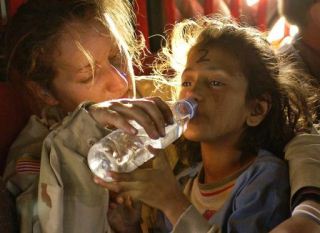 As Japan deals with the horrific impact one of the largest tsunamis on record, it's a good time for all of us to prepare for disasters that may strike closer to home. The tsunami that devastated Sendai was a rare event, but disasters are not rare. FEMA declared 81 disasters in the United States in 2010 and has declared eight already in 2011.
As Japan deals with the horrific impact one of the largest tsunamis on record, it's a good time for all of us to prepare for disasters that may strike closer to home. The tsunami that devastated Sendai was a rare event, but disasters are not rare. FEMA declared 81 disasters in the United States in 2010 and has declared eight already in 2011.
According to FEMA, 42 percent of Americans have no emergency plan and 37 percent have no emergency supplies. That's a problem, says Lise Harwin, communications director for the Oregon Trail Chapter of the American Red Cross.
"Emergency help may not reach you for anywhere from 72 hours, to potentially a week or even more," Harwin says. "So you, or your family, need to be prepared to be on your own for a minimum of 72 hours."
Getting disaster supplies together takes effort – and dollars. For cash-strapped families struggling to keep afloat, preparing for the worst might seem like a luxury. But making the effort to build up an emergency kit and supplies could save your family's lives. And you can build your emergency supplies kit over time, making it far more affordable, if you're on a tight budget.
The Pacific Northwest could be hit with anything from earthquakes, tsunamis, severe weather, fires and health epidemics, to all kinds of man-made disasters. So, all of us should be prepared to spend days without access to water, food, power, transportation or communication. As The Skanner News goes to press. One million people in Japan still don't have heat or water.
So what's the best way to prepare for a disaster on a budget?
 First Comes the Plan
First Comes the Plan
The good news is that step one of preparing your disaster kit costs nothing at all. You simply have to sit down with your family and decide what to do in an emergency. Make a list of questions and answer them. Questions such as: How will you exit your house if a fire occurs? Where will you meet in your neighborhood? Where will you meet if you can't meet in your neighborhood? Who should you call out of state if you can't reach one another? Make a list of essential contact numbers.
Every family will have different needs and issues, Harwin said. "If you have children at school you should check with the school to make sure they have a plan and what that is. If you have a teen you should make sure they have emergency phone numbers and ways to reach emergency services."
Other things to think about: pets; anyone with special needs such as: babies, elderly relatives, people with health needs. Consider talking to your neighbors about their plans.
If you need help with making your plan, check out the step-by-step planner at the Red Cross Web site. The Red Cross also sells emergency kits – but you can easily build your own low-cost kit over time. It's not necessary to buy everything at once.
List the Basics
What would you need if you had to stay put for three days? What if your water supply or electricity failed? Make a list of the essential items that you and your family would need. You can find comprehensive lists of suggested emergency items on The Skanner News' disaster preparedness Web page.
Here's one basic list that everyone should consider:
• Water - one gallon per person per day for at least 3 days
• Food - at least a 3 day supply of non-perishable food, snacks and a can opener
• Flashlight
• Extra batteries
• First aid kit that includes extra prescription medications
• Toiletries and sanitation items
• Tool set that includes tools to turn off your utilities
• Dust mask, gloves, and protective clothing
• Local maps
• Cash in small denominations and quarters for phone calls
• Cell phone with chargers
• NOAA Weather Radio or small hand-cranked or battery –powered radio, so you can hear emergency messages.
 Build Your Store
Build Your Store
To build your kit affordably, plan to buy what you'll need over time. That way you can buy a few items a week, and stay within your budget. Start by collecting the most essential items: water, food, pain relief, extra prescription medications and a flashlight.
The Skanner News found 2.5 gallons of water at a cost of $2.99. So for a family of four, a three-day water supply will cost you just over $15 if you buy it from the store. But if you normally buy milk in plastic containers, you could wash them out thoroughly and fill them with water for free.
Cans of food are a good way to store food over long periods. "If you go to the store and you see a deal for two cans for the price of one, then that might be a time to put one can in your cupboard and one with your disaster kit," Said Lise Harwin. "That can make the cost of building your disaster kit more manageable."
Other items we priced locally included: Dust masks $4:99 for 5; can of chili 95 cents; can lentil soup, $1:50; can of tuna, $2:49; pack of 24 AA batteries,$9:99; Oat Granola Bars, $2:87 for six; Can of peanuts, $2 for 12 oz.; Large waterproof 300-hour light $13:99; apple sauce, $2:99, Family –size Graham crackers, $5:57; large hand sanitizer, $1:99; pack of adhesive bandages, $1:99. And don't forget something to make the time sweeter with treats such as: chocolate, $5 for four bars.
Once you have your basics you can continue building on your kit, adding useful items such as: a crowbar and various tools, electrical tape, disposable cups and cutlery, a smoke detector and so on. Buying everything all at once would be impossible for many of us. But if you break your list down and check of three or four entries every week, you can build an affordable kit this year.
PHOTOS from Wikipedia Commons
Top: U.S. Army Sergeant Kornelia Rachwal gives a young Pakistani girl a drink of water, taken by Technical Sergeant Mike Buytas of the United States Air Force.
Center: Mixed Nuts are a good source of protein and can be easily stored.
- Home
- News
- Opinion
- Entertainment
- Classified
- About Us
 MLK Breakfast
MLK Breakfast- Community
- Foundation
- Obituaries
- Donate
04-19-2024 6:44 pm • PDX and SEA Weather






















































































































































































































































































































